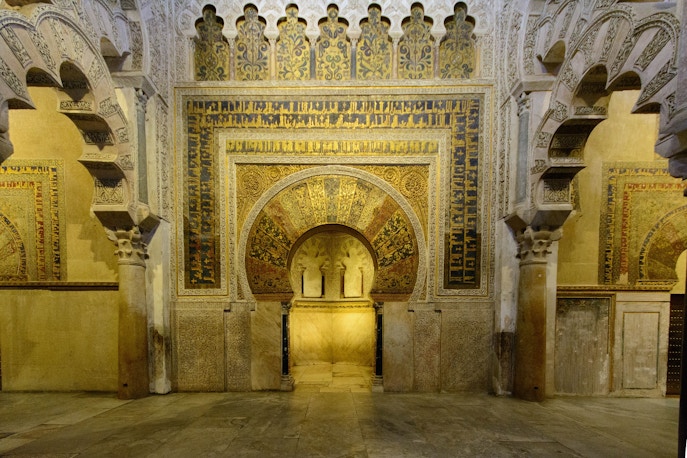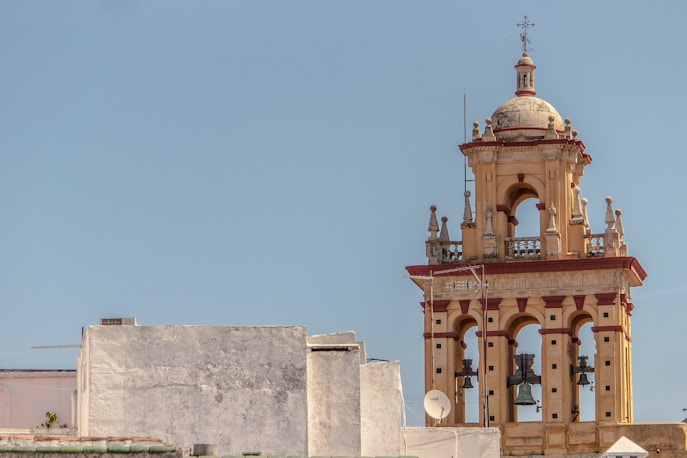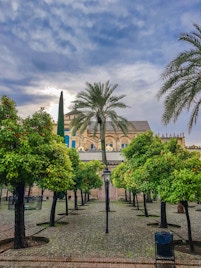The Great Mosque Of Cordoba Architecture | Structure, Expansion & more
The Mosque-Cathedral of Córdoba is a beautiful tribute to the two religions and cultures that have defined Andalusia: Islam and Christianity. A Renaissance church sits atop what was once the Islamic kingdom's most prominent mosque, making this structure a must-see for anybody visiting Córdoba. The Great Mosque of Córdoba, also known as Mezquita-Catedral, is one of the oldest structures remaining standing from the time Muslims governed Al-Andalus in the late eighth century. Córdoba, located two hours south of Madrid via train, attracts travelers from all over the world. Learn more about the Great Mosque Of Córdoba architecture and what makes the landmark truly iconic.
Córdoba Mosque Architecture: Structure & Materials Used

The architects incorporated several Roman columns with ornate capitals into the mosque's design. Some of the columns were already in place in the Gothic building, while others were delivered as gifts from governors of provinces from around Iberia. The ornaments were made of ivory, jasper, porphyry, gold, silver, copper, and brass. Beautiful mosaics and azulejos were created. The red marble columns were supposed to be God's masterpiece, and perfumed wood panels were secured with pure gold nails.
Expansion & Architectural History of Córdoba Mosque
As per the history of The Great Mosque Of Córdoba, the site saw most of the changes due to shift in political power or change in ruler, and later on due to expansion and renovation works.

Original Mosque (785)
The original Aljama's floor plan was based on the basilica model, which was inspired by the mosques of Damascus and Jerusalem's al-Aqsa. A system of stacked arches divides the space, which is separated into eleven naves lateral to the qibla wall. As in the case of the Basilica of San Vicente, the very inventive solution also included the reuse of Roman and Visigoth components from prior projects. Furthermore, the original floor was made of a thick layer of mortar over compressed earth, and the walls are made of limestone ashlars placed using the stretcher and header bond system.

First Expansion (821-852)
Rahman II oversaw the expansion of the prayer hall into eight parts and increased the mosque's length by 24 meters. Due to the political bands that were established at the time with the Eastern Caliphate and the introduction of characters from the east to the peninsula's lands, this extension has a noticeable influence on Abbasid decoration. The architectural aspects of this enlargement are similar to those of the mosque's first phase: contrasting sections and arcs, stone and brick, and overlapping segments and curves.

Second Expansion (951-966)
In 929, Córdoba's city grew in importance in the Islamic world as the caliph Abd al-Rahman III rose to power. A new minaret was constructed during this time, and the mosque's courtyard was expanded. The first minaret of the West was built with these efforts, and it served as a model for Almohad Moorish minarets and steeples. The minaret is currently housed within the Christian bell tower, and while it is no longer visible, the designs and evidence left by the relief of the Puerta de Santa Catalina's spandrels are recognized.

Third Expansion (991-994)
X Almanzor completed the last significant addition of the mosque of Córdoba at the turn of the century. The dearth of this extension's supplies foreshadows the caliphate's demise. Almanzor expanded eastward due to its location and proximity to the mosque river, adding 8 more ships in that route. Almanzor had to confiscate the residences in this region to complete these improvements. The mihrab quedarse was also shifted as a result of the mosque's renovation. Finally, thanks to a combination of stone and brick, the color range of the arches is no longer in this area.
Córdoba Mosque Interiors

Mihrab
The Mihrab is situated in the heart of the qibla wall. It is a focal point for Al-Hakam II's contribution to the Aljama, located between the doors of the Treasury Chambers and the Sabat. It is, however, more than just a location that indicates the direction of prayer. It's also where the expansion's constructive progress converges, and it's where the visitor's gaze is drawn, awestruck by its wealth and creativity.
It has an octagonal structure with a scallop shell dome that rises up from a marble plinth. A quranic surah and an inscription surround the plinth alluding to the creators of the amazing work. The wall panels are decorated with trefoil blind arches and stylized plant motifs. The room has a canted horseshoe structured entrance with geometric mosaic decorations and a plant-based design with inscriptions from the Koran.

Villaviciosa Chapel
The Villaviciosa chapel was the first primary chapel of Córdoba's Mosque-Cathedral. The chapel was built between 1486 and 1496 under the reign of Alhakén II, thanks to the support of Bishop of Córdoba Igo Manrique de Lara and the presence of Queen Isabel I the Catholic in Córdoba. After the Christian invasion of the city in the 13th century, it was the first major renovation to the Islamic mosque.
The execution of the first significant Christian alteration to the structure was made with the construction of a large Gothic nave. The basilica space of the Villaviciosa Chapel is beautified with pointed transversal arches pillars with detailed work, while a wooden gabled frame forms the ceiling. The ceiling was further decorated with pictorial motifs and inscriptions with reference to "Jesus the Saviour".

Hypostyle Hall
The hypostyle hall of the mosque-cathedral dated from the original mosque construction and was once the mosque's principal prayer room for Muslims. During the reign of Abd al-Rahman and his successors, it would have also acted as a classroom and a courtroom for Sharia law matters. The hall was vast and flat, with timber ceilings supported by columns and rows of double-tiered arches.
The arches divide the structure into 19 aisles. With over 850 columns made of jasper, onyx, marble, granite, and porphyry, reused from earlier Roman and Visigothic buildings, the Moorish architecture has a unique structure with a high ceiling that was possible because of the double-tiered arches and relatively low columns. The iconic design is formed by lower-tier horseshoe arches and semi-circular arches. This unique design is described to be resembling the "forest of columns".

Capilla Mayor
The Main Chapel of the Córdoba Mosque-Cathedral was constructed in 1523 to replace the former Main Chapel. According to an inscription preserved in the stairway leading to the vaults, work on the current Main Chapel of the Mosque-Cathedral of Córdoba began in 1523, when Alonso Manrique was Bishop of Córdoba. The chapel not only establishes a lovely cohesion between Gothic, Renaissance, and Mannerism art, but it also blends in perfectly with the Caliphate tradition.
The Gothic-style enclave of the Capilla Mayor is decorated with a ribbed vault and a stunning iconographic series, designed by referring to the Assumption of Our Lady. The structure is further beautified with figures of musical angels, saints, and apostles. Like the other sites of the structure, the Main Chapel has beautiful ceilings. The transept of the Main Chapel has an oval vault that is beautified with four evangelists and iconic figures.

Choir Stalls
The stalls from the former main chapel were reused, resulting in the formation of a new and opulent ensemble. The ambitious commission was made feasible by Archdeacon José Daz de Recalde's notarial bequest of 120,000 reales in 1742. Duque Cornejo was chosen to construct the stalls after other sculptors submitted models and designs. As a result, on March 14, 1748, he began work on an ensemble that would eventually have 30 upper and 23 lower seats.
Restored in the period between 2006 and 2009, the choir area is built with a Mannerist style. A lowered barrel vault is structured in lunettes forming projecting angles. Curved out of mahogany wood, it features a row of 30 upper seats along with 23 lower seats, each decorated with an extensive carving of a series of iconographic scenes. The center is beautified with a huge episcopal throne, which resembles the altarpiece design.

Parroquia del Sagrario
The modern Parroquia del Sagrario was built on the location of the Chapel of Santiago and the Chapter Library. Since the last quarter of the 16th century, this space has been a Sanctuary of the Cathedral, thanks to the work of the architects Hernán Ruiz I and III. The chapel is rectangular in design, with three naves and a ribbed ceiling covering it. The major draw is a collection of murals commissioned by Bishop Antonio de Pazos y Figueroa that adorn the whole room.
In the murals, we can find the presence of the holy Córdoba martyrs with detailed texts talking about their lives and martyrdom as per the testimony given by Ambrosio de Morales. The iconographic scenes are accompanied by paintings of beautiful landscapes, angel compositions, and symbols of the Passion, of which, scenes of the Holy Supper get the most attention from the visitors.

Capilla Mayor Altar
The main altarpiece of Capilla Mayor was created between 1618 and 1628 using Carcabuey marble. It was designed by Alonso Matas, who supervised it until 1625 when Juan de Aranda Salazar took over. The central temple remained unfinished until 1653 when Sebastián Vidal completed it according to his predecessor's drawings and sketches. Pedro Freile de Guevara was primarily responsible for the sculptural section, which was completed in 1626 with the help of Matas Conrado and Juan Porras, among others.
Executed by sculptor Miguel Verdiguer, the altarpiece has pulpits on either side of the main arch made of marble and mahogany. The altarpiece has a unique design of three vertical aisles and composite capital columns.

Bell Tower
From the original Muslim minaret to the contemporary Bell Tower, this landmark has played a significant part in the image and profile of Córdoba. While it has had the same core function of summoning the faithful throughout its history, its forms and styles have evolved throughout time. It is the city's highest skyscraper, standing at 54 meters. The Cathedral's liturgical life is still governed by the ringing of bells. The collection of bells known as "liturgical bells" is the most notable among them.
The minaret was built by Abd al-Rahman III in the mid-10th century which was later demolished and renovated as the modern-day Renaissance bell tower with a solid square shaft and serliana-style openings on all four sides.

Patio de Los Naranjos
The previous Caliphate ablution courtyard was eventually transformed into a Christian courtyard. Hence its role has changed dramatically over the building's history. After serving as a venue for ablutions or ritual washing before Muslim prayer, it became one of the most important areas in the Cathedral for Catholic ceremonies, hosting the most solemn events. Rows of orange trees, palms, and cypresses are planted in the outward continuation of the prayer hall's columns.
The courtyard has visible stone channels which are believed to be a part of the alteration projects of the mosque. The fountains and water basins were used in the rituals while the arches to the prayer hall interior were designed to be open to allow natural light.
Important Doors Of The Great Mosque Of Córdoba

The Door Of Forgiveness
One of the most significant doors in the Cathedral's ceremonial life, the Door of Forgiveness is believed to be the passage of some of the most important religious solemnities. It was completed in 1377 and has since undergone many renovations, including one in 1650 by architect Sebastián Vidal. On it, the remains of some mural paintings attributed to Antonio del Castillo may be seen.

The Door of Saint Catherine
In the year 1268, the name of the door of Saint Catherine was written and recorded, pointing to the adjacent presence of the ancient convent of Saint Catherine. Its current appearance is the result of architect Hernán Ruiz II's Renaissance transformation. The structure of the door is a semi-circular arch equipped with two columns, with a Zerlina providing the development of the second body.

The Door Of The Palms
This was formerly known as the Blessings Arch since it was here that each new monarch's royal banner was blessed as part of the coronation process. In the year 1533, Hernán Ruiz I was authorized for its refurbishment, which included the addition of an upper plateresque structure with the Annunciation relief. Surprisingly, miniature mythological entities appear in the lower corners next to this image.

The Door of the Deans
Given that its origins stretch back to Abd al-Rahman I's initial mosque, this is one of the Monumental Site's oldest doorways. Despite the multiple changes it has endured, the arch's structure is still based on conventional Visigoth architectural models. The voussoirs are carved in a radial pattern, interweaving stone and brick.
List Of Important Doors Of The Great Mosque Of Córdoba

West facade(North to South)
- Postigo de la leche
- Puerta de los Deanes
- Puerta de San Esteban
- Puerta de San Miguel
- Puerta del Espíritu Santo
- Postigo del Palacio
- Puerta de San Ildefonso
- Puerta del Sabat

East facade(North to South)
- Puerta de la Grada Redonda
- Fuente de Santa Catalina
- Puerta de Santa Catalina
- Puerta de San Juan
- Puerta del Baptisterio
- Puerta de San Nicolás
- Puerta de la Concepción Antigua
- Puerta de San José
- Puerta del Sagrario
- Puerta de Jerusalén

North facade(West to East)
- Puerta del Perdón
- Puerta del Caño Gordo
Córdoba Tickets & Tours
Frequently Asked Questions About Architecture Of Córdoba Mosque
A. The architecture of the Córdoba Mosque combines Islamic, Gothic, Moorish, Renaissance, and Baroque elements.
A. The Córdoba Mosque is regarded as an important monument in the history of Islamic architecture, and many academics believe it had a significant influence on succeeding "Moorish" architecture throughout the Muslim world's western Mediterranean regions.
A. The Córdoba Mosque was built upon the ruins of the Visigoth Basilica of San Vicente in the 8th century. Find out more about the origin of the Great Mosque Of Córdoba on our history page.
A. The Córdoba Mosque was converted into a Christian cathedral in the 13th century.
A. Currently, the Córdoba Mosque serves as one of Spain's major historic monuments and tourist attractions.
A. The Door of Deans, The Door of the Palms, The Door of Forgiveness, and The Door of Saint Catherine are the 4 important doors of the Córdoba Mosque.
A. The Door of the Deans is the oldest door of the Córdoba Mosque.
A. Yes, while the Córdoba Mosque features Gothic and Renaissance elements, it prominently displays Islamic architecture.
A. The Córdoba Mosque is a prime example of Moorish architecture, an Islamic art form that flourished on Spain's Iberian peninsula during Islamic rule.
A. The combination of two elements, stone, and brick, is the most distinguishing material used to build the Mosque of Córdoba. The many types of stone used in the mosque's construction include marble, jasper, and granite.
A. The first expansion work of the Córdoba Mosque was done between 821 and 852. Find out more about the expansion works of the Great Mosque Of Córdoba on our architecture and history page.
A. The second expansion work of the Córdoba Mosque was done between 951 and 966. Find out more about the expansion works of the Great Mosque Of Córdoba on our architecture and history page.
A. The third expansion work of the Córdoba Mosque was done between 991 and 994. Find out more about the expansion works of the Great Mosque Of Córdoba on our architecture and history page.
A. The original Córdoba Mosque was built in 784–786 by the Umayyad monarch Abd ar-Raman I.
A. The Córdoba Mosque is famous because of its vastness and the sheer height of its ceilings, which is a one-of-a-kind aesthetic feat. It is the most prominent landmark of Islamic religious architecture and an irreplaceable testimony of the Caliphate of Córdoba.
A. The Córdoba Mosque encapsulates everything of al-Andalus' magnificence throughout the caliphate period, making it well worth a visit.
A. Yes, you can buy the Córdoba Mosque tickets online.
